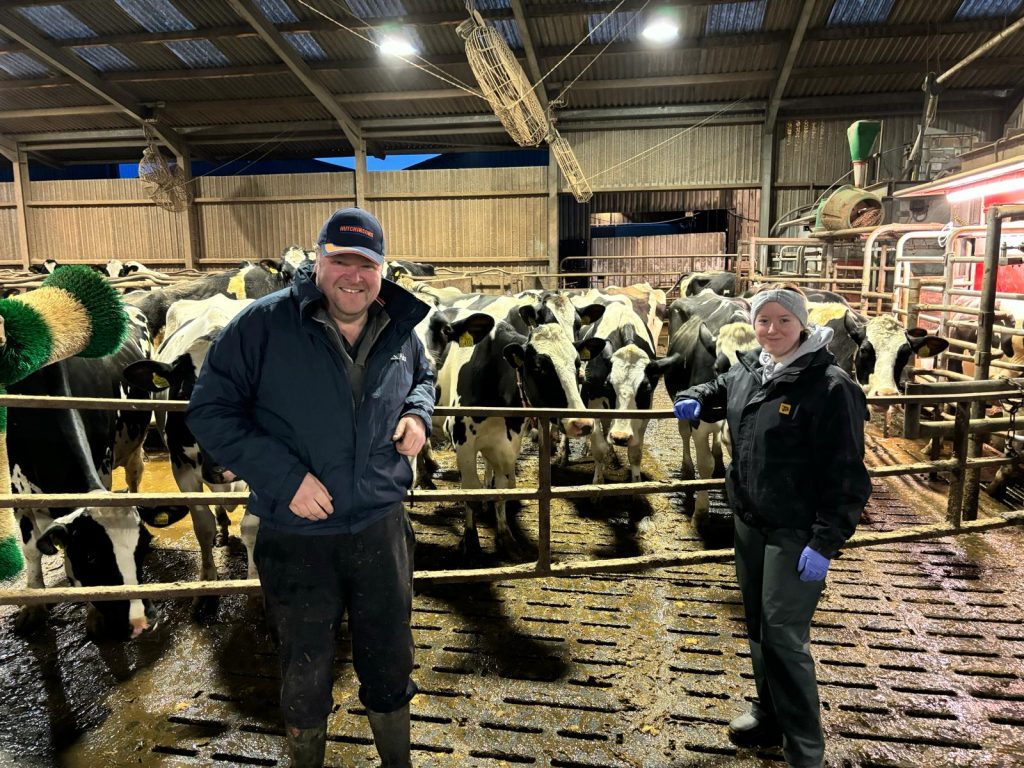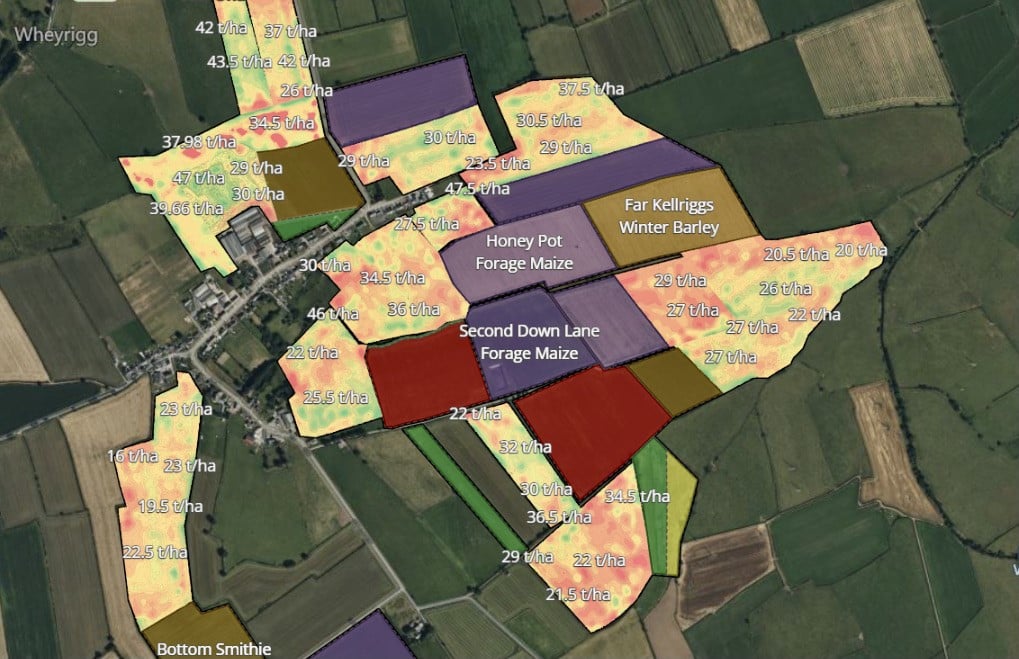Digital mapping drives forage productivity
A farm in Cumbria is proving that digital soil and yield mapping can deliver big benefits for dairy units through increased productivity and more targeted use of inputs ...
Blencogo House Farm near Wigton is no stranger to adopting the latest technology, running four Lely robotic milking units alongside the parlour for its 260-cow herd.
The farm, which also grows its own forage and straw from around 150 ha of maize, winter wheat, winter barley and perennial ryegrass, has also been an early adopter of the latest in digital mapping technology in a bid to drive productivity and efficiency.
Several years ago, it started using the Omnia Digital Farming system, primarily to produce nutrient and manure management plans, and more recently, was one of the first in the area to have fields scanned with Terramap High Definition soil mapping soon after the service was launched in 2019. Terramap uses gamma-ray detection technology to map all common nutrient and physical soil properties in far greater detail than conventional grid sampling, mapping over 800 data reference points per hectare.
“Our Hutchinsons agronomist Jim Clark is a big believer in the Terramap system, so we thought that maybe it could be the next step in achieving better productivity,” says farmer, John Ferguson. “From what we’ve seen so far, it’s definitely worth doing.”
Big lime saving
The first fields were Terramaped four years ago, and now the vast majority of the farm – predominantly sandy clay loam soil – has been scanned, with all data uploaded to Omnia where it is analysed and used for nutrient planning and to create variable application plans.
One of the most tangible benefits has been on the use of lime, which has traditionally been applied ahead of maize at a flat rate of around 2.5-5 t/ha (1-2 t/acre) based on results of standard soil core sampling.
But once Terramapping revealed the underlying variations in soil pH across both the farm and within individual fields, it was clear a more precise approach was needed. “Some fields were more variable than others, but generally the variation was between pH 5.6 to 6.5,” says Mr Clark. “My aim is to bring everything up closer to a target pH 6.5, which is slightly higher than the 6.0 recommended in RB209 for grass, but I feel a higher pH helps achieve greater nutrient availability from slurries, which is what we need for big crops of maize, wheat and grass.”
The farm enlisted a local contractor who had just invested in new equipment to variably apply lime, and provided them with the variable rate application plans drawn up in Omnia and exported to the contractor electronically.
“There was one 18-acre field in that first year which only had a patch the size of a football pitch with low pH that needed treating, so in that field alone, there was quite a saving,” notes Mr Ferguson.
Indeed, across the 58 ha that was Terramapped and limed last season, a total of 137 tonnes of lime was applied variably, representing a saving of 152 tonnes compared with what would have been used if that same area had received a blanket application at the standard rate.
“At the time, lime was around £20/t, so we saved around £3,000 on lime alone,” notes Mr Clark. “Even after you factor in the cost of soil scanning those fields at £1,600 and the £800 to precision spread lime, there is still a saving of several hundred pounds. And you have a whole host of map data for future use. At today’s prices for lime at £25/t, the savings would be even greater.”
But while the savings are very welcome, that is not the sole aim for Mr Ferguson, who says that reducing the variability of fields is key to improving productivity and using fertilisers – both organic and any supplementary bagged products – more efficiently.
He already believes crops are more uniform where lime has been applied variably, and hopes future improvements will become evident with the use of yield mapping on the forager. “Our contractor only started yield mapping for the first time last year, so we’ve not really got anything to compare the 2023 maps to yet, but it will be useful data to show how effective any management changes have been.”
Mr Clark agrees. “Yield mapping is a good monitor of the farm. If you’ve corrected something, you’ll hopefully see the impact in yield maps within a year or two, rather than having to re-scan with Terramap every other year instead of every five years, which is the preferred approach to monitor longer-term changes.”
Targeting manures and slurry
Blencogo House Farm has invested heavily in winter slurry storage in recent years, having built a new lagoon on the arable side of the farm, allowing slurry to be applied to cropped land in the spring via an umbilical system and dribble bar or trailing shoe applicator.
Mr Ferguson hopes he will soon be able to use Terramap data to variably apply slurry, targeting applications and rates according to levels of soil potash and phosphate. Fields closer to the main farm buildings have historically received more manure and slurry, so generally have high soil indices, whereas levels can be slightly lower in fields further away.
He is already using Terramap data to target farmyard manure applications more accurately to where they are needed to build soil P&K levels, although this is done manually, rather than with variable rate applications.
Fields, or areas of fields, where Terramap data shows low P&K are easily identified in Omnia, and giving operators access to these maps on their phone or iPad in the cab means they can apply manures exactly where needed, says Mr Ferguson.
The farm is also in the process of installing a slurry separator, which will allow them to target different organic fertilisers – manure, slurry or separated manure – each with its own nutritional composition, exactly where needed.
“Our whole focus is on trying to make better use of what we’ve got on the farm in the form of slurry and manures by applying it in a more targeted way, rather than buying anything in bagged form,” adds Mr Clark.
Wider mapping benefit
With increasing focus on soil health and environmental sustainability across all sectors of agriculture and the wider food chain, Mr Clark points out that many milk processors are interested in the potential of digital mapping technology on dairy farms.
Of particular interest is the potential to improve nutrient use efficiency and sustainability, and reduce the use of manufactured fertilisers.
“By correcting the pH, it ensures we’re getting the most out of any slurry being applied, which is a win-win for both the productivity of forage crops and the environment.”
Accurately mapping soil nutrients also allows fertilisers to be tailored to specific situations, he adds. For example, some growers still routinely apply compound NPKS aftercut fertilisers, but there is unlikely to be any need for this when soil indices are high, where a straight nitrogen-sulphur fertiliser may be sufficient.
Mr Ferguson also notes that having all information in one place within Omnia makes it much easier when it comes to farm inspections, such as Red Tractor. “It was so easy to pull up all of the information they needed, without having to go through different files.”
Mr Clark concludes: “This is just the start. In the next five years, I think a lot of dairy farms will be digitally mapping.”
Blencogo House Farm
- 260-cow dairy herd
- 150 ha of maize, winter wheat, winter barley and grass
- Started Terramapping in 2019
- Focus on variable lime applications to reduce pH variability and hit target levels
- Plans to variably apply slurry in future
- Utilising yield mapping data to evaluate crop performance


